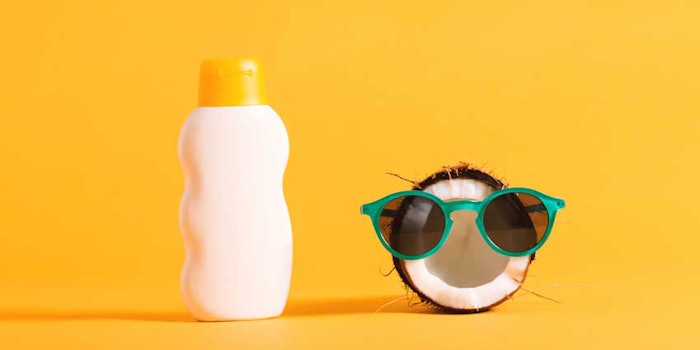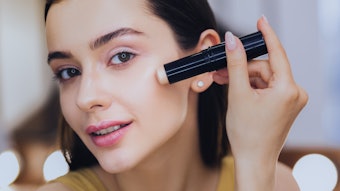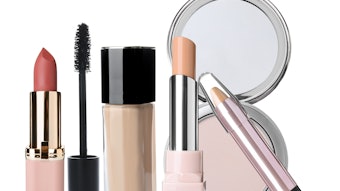
For consumers seeking a dark brown glow to their skin, either naturally by the sun or by targeted chemical reactions, tanning products are important to skin health. It is also important for such products to have the appropriate olfactory aesthetics to reinforce their functional benefits as well as provide the best possible experience for the user. Outdoor, indoor and self-tanning products have different usage profiles and provide discrete benefits to their end consumers. Thus, fragrancing each type of tanning product has special considerations with respect to the overall fragrance structure and the types of characters that work best.
Fragrance Structure Review
Fragrances are generally considered to include a top note, middle note and base note. In practice, these notes are not completely mutually exclusive and the division between them is quite subjective. The top note is comprised of characters that are immediately evident upon application of the fragrance or product. Usually these characters are based on the fragrance materials having the highest volatility, i.e., the lowest boiling point, in the fragrance formula. Examples of top note characters include citrus notes such as orange, lemon, lime and bergamot; leafy green notes; aromatic minty notes; ozonic marine notes; light, fruity notes such as green apple or pear; and some green floral notes such as hyacinth.
In an alcohol-based fragrance, such as one would find in a department store, the top note is the “hook” or the part of the fragrance that draws in the consumer, gives the initial impression of the fragrance, and sets the expectations for the remainder of the fragrance. It is also the part of the fragrance that provides the “freshness” so somewhat by definition, an extremely “fresh” fragrance would tend to have a higher proportion of top note.
The top note is quickly followed by the middle note, or heart note, which is the part of the fragrance that is usually the overall recognizable character. Middle notes generally include floral notes such as rose, the lighter characters present in jasmine, orchid, geranium and freesia; heavier fruity notes such as coconut, peach and berries; and the lighter general woody characters. Some spices such as coriander seed and herbal notes like basil are also used as modifiers for a middle note. More masculine fragrances may contain a larger proportion of a lavender character in the middle note. The middle note must be harmoniously blended with the top note and support it in a way that is pleasing while having its own character.
A fragrance base note is the longlasting part—i.e., the portion having the highest boiling points or lowest volatility, of the fragrance, which can be recognizable in an alcohol-based fragrance for as long as 24 hr. These base notes are usually comprised of heavy floral notes such as the heavy characters present in jasmine, tuberose, heavier woody notes such as sandalwood or patchouli, musky notes and amber characters. Sweet notes such as sugary or vanilla notes can also fall in the middle to base note range, depending on the structure of the entire fragrance. The base notes definitely support the top and middle notes, and while they are not obvious initially, they affect the perception of the top and middle note characters. Base note fragrance materials have the least volatility and tend to be substantive to the skin. They are the part of the fragrance that provides “richness” and therefore, a very rich fragrance often has a higher proportion of base notes than, for example, a fresh fragrance.
Movement and Linearity
The “movement” of a fragrance is most simply defined as the change in fragrance character over time—a sort of evolution of character. Designing how much movement a fragrance has is important in most applications. For example, to be successful, fragrances for alcohol-based media such as a perfume, eau de toilette, or body spray should have a recognizable top note, middle note and base note, but the harmony and transition between each note over time is carefully crafted by the perfumer who must take into account the volatility of each fragrance ingredient to yield a recognizable and pleasing combination of character and intensity in the final fragrance. The consumer expects the alcohol-based fragrance to smell a certain way upon application but then to change or move over a period of time to a different, yet characteristic, odor.
In contrast, some applications require a fragrance that has the opposite of “movement,” which is “linearity.” A fragrance that is linear is composed of materials with similar volatility. For example, consider a classic baby powder fragrance. From the moment of application to the next morning, the complex powdery fragrance is recognizable as a baby powder fragrance with only limited change. The powdery character itself is composed of a combination of heliotrope, cedar, rose, geranium and musk, but all of these have a similar volatility profile such that the fragrance is cohesive and easily recognized. A traditional baby powder fragrance is very substantive due its fragrance structure, and this powdery character functions well for blending with or almost masking urine odors, and it has clear product recognition. As a result, the entire baby product is cohesive, functional, recognizable and obviously very successful.
Outdoor Tanning Products
Outdoor sun care products that include an SPF are typically emulsions of sunscreens in a lotion-type base. From a fragrance side, the sunscreen actives have a very typical odor that is, fortunately, somewhat recognizable by consumers as “sun care” or even has been described in sensory panels as “beachy.” However, these materials have a heavy floral balsamic salicylatelike odor, which falls in the middle or base area of the fragrance structure, and which must be at least partially masked to impart a characteristic, differentiable fragrance in the tanning product.
The most typical fragrance direction for outdoor sun care products is a mixture of the sunscreen base odor with some type of classic “beachy” fragrance, usually orange flower, sweet coconut or a very sweet and heavy tropical odor. As is the case with the classic baby powder fragrance, there is a real reason behind the success of the classic outdoor suntanning fragrances beyond the marketing and advertising of their respective products that is attributable to well-designed fragrance structures and characters that are not only functional, but recognizable.
An example of a classic beach fragrance is a very linear orange flower type. Like the baby powder fragrance, this type maintains its character from application on, with little movement in character. It is very substantive as it is based on base note characters so that it remains on the skin for hours, even under high heat, humidity and exposure to water. And although it is substantive and composed of materials with low volatility, the floralcy of the character is diffusive enough to at least partially mask the odor of the aromatic floral salicylate odor contributed by the UV sunscreens. Fortunately, but certainly not entirely by accident, the aromatic floral salicylate odor of the sunscreens actually blends fairly well olfactorily with this orange flower fragrance so that the product is cohesive and effective during the entire usage profile and therefore functional, recognizable and successful.
Indoor Tanning Products
In climates where outdoor tanning is not possible, or to expedite the tanning process, consumers sometimes use concentrated sources of UV light such as tanning beds to tan their skin. In this case, the tanning lotion does not contain sunscreens but may include other active materials such as accelerators, bronzers or large amounts of moisturizers or emollients that can affect the base odor of the lotion and interact with fragrances.
Fragrances for indoor tanning products should cover the odor of the product base; however, the usage profile of such products is quite different from outdoor tanning products. This makes fragrancing them more difficult because while outdoor fragrances are applied to be used over long periods of time in the open air, indoor tanning fragrances are applied and used, more or less, only for as long as the tanning session is in progress. The consumers will be indoors and in even closer quarters when they are in the tanning bed itself. Further, consumers may have off odors produced by sweating or interactions of the tanning lotion active with the skin, which may be more apparent under these conditions.
Generally, fragrances that work well for indoor tanning products are much more top and middle note oriented than the substantive, linear fragrances seen in the outdoor market, which leads to a wider variety of fragrance characters possible for this type of product—and there are a number of fragrances that are very successful in this market. From a purely structural perspective, the higher proportion of top notes works well to cover any odor from the product base and its actives while providing the tanner with a burst of fragrance to enhance the tanning session. The middle notes in combination with these top notes meld to create a characteristic odor for the product that enhances the product positioning and benefits.
The specific fragrance characters should be chosen to cover any volatile odors from the skin and the actives in the lotion itself. For typical indoor tanning lotions without much base odor, combinations of citrus notes such as sweet orange and fruity peach or berry notes combined with sugary and vanilla notes have been particularly effective for blending with and masking the skin odor that may follow a tanning session. The reason they seem to work may be that when one blends orange with the sulfury notes of sweat, the character is not very offensive; it merely shifts toward a grapefruit direction. Similarly, sulfury notes with peach twist toward mango, and with raspberry, twist toward blackberry. Therefore, the fragrance does not need to overcome the odor but merely twist it to something more palatable.
A certain proportion of residual characters are used in the products to cover any lingering odors on the skin. Heavier fruity notes such as peach and coconut work well to cover odors on the skin and are well-recognized as tanning type notes by consumers. Their creamy character also enhances the perception of lasting moisturization by the tanning product. A small proportion of musk character may extend the longevity of the fragrance on the skin without overwhelming the consumer.
Self-tanners
Self-tanners or bronzers are a common alternative to sunscreens for those consumers who wish to tan without UV exposure. Active levels in such products vary; therefore the fragrance structure and characters that work well in the products vary. The usage profiles of bronzers fall into two main categories: the low-dose, daily use variety and the one-dose, fast-acting type. The type of fragrance required is highly dependent on the concentration of the active concentrations of dihydroxyacetone (DHA) and erythulose in the product, as well as any other excipients and delivery vehicles that may be added.
The chemical reaction of the DHA and adjuncts with the thiol-containing amino acid cysteine in skin proteins creates a color change in the skin beginning as soon as about 30 min after application and continuing for several hours. This reaction also creates an off-odor that is fairly offensive to most people. The odor is somewhat sour and “wet cardboardlike” in nature. This odor actually indicates the chemical reaction is occurring and it changes over the course of the reaction. There can be some initial sour odor and the odor continues to develop or bloom at about 3–4 hr after product application, and may continue for some time afterward. Therefore, the fragrance for these products must be longer-lasting than indoor tanning products while being fairly unobtrusive, since many of these products are applied as part of a morning routine.
The usage profile for the daily use product involves applying a small amount daily and having the resulting “tan” build up over time—faster than the skin is sloughed off. In this case, the product is almost like a daily use lotion and the fragrance profile would be similar to such as product type but have a longer-lasting or more substantive fragrance than would be seen in a normal lotion. This can be accomplished by either adding more fragrance to the product, or using a longer-lasting and more linear fragrance than a typical lotion fragrance. Either option can be more expensive than a typical fragrance for a similar product without active materials. The most preferred option would be to add a well-designed linear fragrance with a base note somewhat similar in structure and character to the outdoor tanning notes, which are wellsuited to disguise the sour cardboardlike notes that occur in this reaction. However, care must be taken by the fragrance house not to use materials in the fragrance that can react with the active materials prior to the application to skin.
For a one-time application product, the fragrance can be more prominent and distinctive such as that seen in the indoor tanning products but still must be long-lasting to cover off odors created by the bronzing reaction. The best way to accomplish this is to add a relatively high level of fragrance to the product since it likely will be used for a one-time application rather than daily. The fragrance itself can be seen as part of the usage experience and a point of differentiation between products in this category. Characters seen in indoor tanning products are good for a start but again, long-lasting linear base notes are required to help cover the odor of the chemical reaction with the skin. Various other materials such as solubilizers added to the product base may help prolong the fragrance duration.
Choosing Successful Tanning Fragrances
Understanding the usage profile for the product and the potential evaluation points by the consumer is key to the choice of a fragrance for a tanning product. Determining the length of time the fragrance should be effective and the prominence of the fragrance character over the relevant time frame is essential in ensuring the overall fragrance structure is appropriate for the product. Generally, the fragrance character can be suited to the fragrance structure needed, within limits. However, there are certain fragrance characters that are inherently more successful than others within specific product types for the reasons previously described. Providing the unfragranced base to a fragrance house will allow perfumers to see firsthand any areas that may need to be addressed.
Fragrance Safety
Tanning, whether via sunlight, UV tanning beds or the use of active chemicals, is an activity that has the potential for adverse reactions with the end consumer. To this end, much emphasis is placed on the safety and design of fragrances for these types of products. Reputable fragrance houses are very conscious of any regulations regarding tanning products and can address them as long as they are aware of the final product destination of the fragrance. For outdoor and indoor tanning fragrances, the fact that they are exposed to UV light is important as the potential exists for phototoxic dermal reactions between fragrance materials and skin in the presence of light. Phototoxicity is one of the first known issues with fragrances to be identified, and the use of materials that may be reactive is now tightly controlled as an industry.
For self-tanners, the fragrance house must be aware of the potential for reaction of the active materials with various fragrance materials. Reputable fragrance houses will conduct stability testing in the relevant product bases, as well as some testing to show that the fragrance positively enhances the product usage. However, providing information regarding the actives and the types of reactions that may occur will streamline the fragrance development process.
Summary
Fragrances positively enhance the product usage profiles of tanning products either by masking the odors of the active materials or the results from using the active materials, and also enhance the consumer’s experience in using the product. By matching fragrance structures to the product’s usage profiles and coordinating the fragrance characters to the type of tanning product, the market offerings have the best possible chance to enchant the consumer and have a lasting successful presence in the marketplace.










